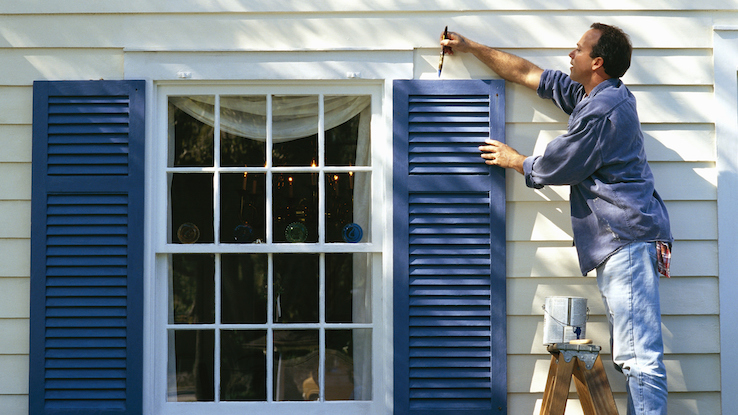What Type of Paint is Easy to Clean

Painting your house is a relatively big improvement job, but it can freshen up the look of your home, give it a different appearance altogether and even help seal the outer surfaces of the house to protect them from humidity and weather damage. Whether you want to give your place some character or get it looking its best in preparation for a sale, painting is a quick way to make a big impact. If you're planning on painting the exterior of your home yourself to save on costs, these tips can help you make the most of this project.
Check the Forecast
While you can paint your house when it's raining out, it's best to wait for a block of sunny days during which to complete the entire job. Precipitation can slow the project, making it difficult to get work done — will you really feel comfortable and safe climbing ladders in a downpour? Raindrops can also ruin your paint job, causing the new hue to become streaky, and they can also splatter paint onto surfaces of your home (like your windows) where you don't want paint to travel. Humidity interferes with the paint's ability to dry quickly, and windy weather can cause the paint to dry too fast — yes, that's a thing, and it can make large cracks form in the paint. It's best to wait for a block of sunny, calm days (between 60ºF to 90ºF) to complete your project. Ever noticed how painting companies are busiest during the summer? This is why.
It might be tempting to slap those fresh coats on as quickly as possible if you're nearing the end of your rope looking at that flaking, cracked old paint. But some prepwork is essential for helping the paint look its best and last as long as possible. Before you begin painting, take the time to pressure-wash the exterior of your house. This helps remove some of the chipping paint, but it also provides a clean surface for the new paint to stick to. Remove all the dust, cobwebs, dirt, moss and algae by starting your washing at the top of your home near the roof and working your way down. Use a low power setting to prevent the stream of water from damaging siding and knocking shingles loose. Softer materials like stucco and wood do best at 1,200–1,500 psi (pounds per square inch, or the amount of pressure the water puts on the surface), and harder materials like brick and steel can handle higher levels of 2,500–3,000 psi.
Don Your Construction Cap
No need for a hard hat here — just be prepared to make a few repairs as necessary. Like cleaning exterior surfaces, repairing damaged spots on the outside of your home makes the paint look best and last longest. Plus, when you're dedicating this much effort to get your house freshened up, there's no better time to tackle those small jobs you've been putting off. Work your way around the home, taking note of spots where you see peeling paint, gaps in caulking splintered wood or any other areas of similar damage that can affect how well the paint applies and dries. Sand away chipping paint and splintered wood. Scrape out old caulk and re-apply new caulk around door and window trim. Use a spackle knife to apply epoxy filler to small cracks and holes, and sand these areas smooth when dry. If you find areas of rot, it's best to replace them completely — the paint won't stick to the decomposing wood.
Go for Quality
While paint technology has improved by leaps and bounds over the past few years, there are still some not-so-spectacular options on the market — and they're usually the cheapest ones. It pays off in the long run to treat this project as an investment in your home; choosing the highest-quality paint you can afford means a better overall look and a longer interval between now and the next time you'll need to paint. Higher-cost options typically provide noticeably better coverage and are much more durable over the long term, lasting 15 years or more.
Know Your Type
While oil-based paints were once the darlings of house painters everywhere, they've slowly fallen out of favor as acrylic has risen to the top. And you'll likely want to choose acrylic, too. Why? They offer outstanding durability and perform better than most other formulations on a wider variety of surfaces. Exterior-grade acrylic paints adhere nicely to surfaces like stucco and wood, but they're also best for masonry surfaces like brick and stone, which need to allow water vapor to pass through them — something oil-based paints, which trap moisture, don't do. Oil-based paints do have their place, though; they're best for high-touch surfaces like doors or those that need added durability, such as the floor of a porch.
Don't forget the gloss, either. This describes how shiny and reflective the paint is — and also how it performs. Satin and eggshell finishes are best for the majority of your home's exterior because they mask imperfections but provide just enough shine over matte paints to make them more durable and easier to clean. Semigloss paint is best for trim, particularly on areas like window sills that might endure rain or snow sitting on them, due to its improved durability. High-gloss paint, like its name indicates, is quite shiny and shows even the smallest imperfections. It's best for adding some pop to shutters and doors.
Source: https://www.questionsanswered.net/lifestyle/tips-painting-your-homes-exterior?utm_content=params%3Ao%3D740012%26ad%3DdirN%26qo%3DserpIndex&ueid=9fdd79e5-9f16-4206-bedf-be17020ab6c5
0 Response to "What Type of Paint is Easy to Clean"
Post a Comment